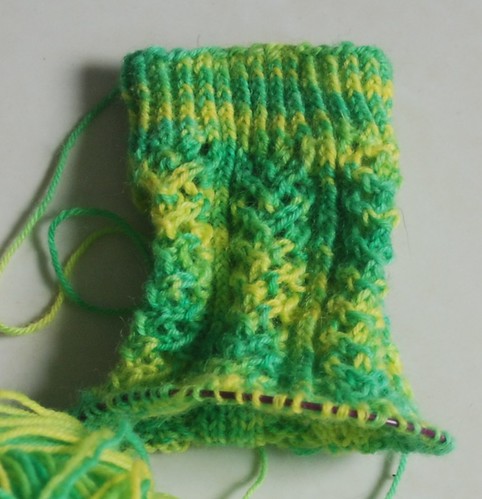I always like the look of variegated yarns before I start to knit with them – the colours contrast so nicely! However, they never seem to look as good knitted up, so I tend not to buy them. I made an exception for this lovely green and yellow sock yarn – I don’t normally go for yellow at all, but this particular yellow paired with this particular green did appeal. It has taken me some months to find a way of knitting with it where I liked the result.
This is really a four-part blog post, but as I can only post one picture at a time, it will have to be four separate posts. The posts should be read in reverse chronological order, i.e. variegated yarn, first attempt, second attempt, success.
Thursday 26 July 2012
Variegated yarn
First attempt
I wanted to make a pair of socks with the yarn. I didn’t want to do a scarf or hat, because putting yellow next to my face doesn’t suit me, and I already have enough pairs of gloves. I choose this sock pattern. After a few inches, it was clear that the pattern and the yarn don’t work together. The colour variation obscures, rather than shows off, the lace pattern, and I didn’t like the way the colours were pooling. I do like the pattern, and will probably knit it again in a solid colour wool.
Second attempt
For the second attempt, I found a pattern for socks using linen stitch. Linen stitch uses slipped stitches and brings the wool forward in front of some stitches, both of which mix up the colours a bit. I was hoping that this would get rid of the pooling but, as you can see, it didn’t. I rather like the part on the right, where the green and yellow are very mixed up, and if the rest of the sock had been like this I would have persevered.
Success!
In the end I bought some more wool in a harmonising colour (the dark green), and did a simple plain striped sock. This works! The dark green breaks up the large areas of yellow, and the overall effect is bright and cheery. Now to knit a second sock, so I can wear the pair...
Saturday 7 July 2012
Japanese Rhinoceros Beetle
Japanese Rhinoceros Beetle a video by joe with a camera on Flickr.
Greetings all - if you still remember us. Sorry about the hiatus... one thing after another, and then we just got out of the habit. Anyhow, here's a good one to get back into the swing of things. If the video doesn't run automatically, click and it should take you to Flickr, where it does.
These little beauty was found on the way into work, on the pavement, upside-down. The previous day we'd found a female in the same place, and in the same rather undignified posture. Coming from a country where the bulkiest insect you can find is the stag beetle, this lumbering tank was quite a surprise.
For some reason, it didn't take long to work out it was Trypoxylus dichotomus, a relatively common species in the far east, but most typical of the northern areas. The larvae live in rotten wood for a few years before emerging (imagine the size of the hole... not great if you've got them in your furniture, I imagine), whereapon the males battle each other endlessly for the attention of the females. The ridiculous horns are perfct for flipping each other over, but can probably also inflict some serious damage on opposing appendages if twisted the right way. We found another male that was apparently unable to walk (or even stay upright - a common complaint, it seems), with one of its legs not working. It might not have been a rival... but it probably was.
These animals are apparently popular pets, and I can see why - they have so much personality. Inevitably, though, they're often made to fight each other... which is fine up to a point, of course, as that's what they do, but I imagine there's a natural limit to how often they encounter each other and choose to do battle. Less inevitably, they're apparently sold as pets in Japan... from vending machines. Yes, I'm sorry to say you read that right. Ho-hum.
A few interesting facts... I read on forum somewhere that the size of the adult depends on the quality of the food given to the larvae (reasonably enough). Those who tried feeding them an apparently nutrient-rich diet of leaves and mulch, however, ended up with smaller adults than those feeding them on wood alone. I guess their digestive system is geared towards wood, and they can get more from a twig than they could from a hefty Greek salad with added bamboo shoots.
Apparently (http://natureafield.com/?p=722) the enormous horn doesn't stop the males flying as far and as fast as the (hornless) females. To compensate for the weight, they've evolved larger muscles and so on, which presumably does require more energy... so I'm not sure exactly what the study really showed, to be honest. Interesting, though, and it must be quite fun sticking tiny radio transmitters onto them.
Finally... apparently they have quite a mainstream profile in Japanese media. If anyone has seen the classic (sort of)film "Godzilla vs. Megalon", you may notice some familiarity in Megalon's facial protuberances... yes indeedy, the god of Seatopia is apparently a giant bipedal mutated T. dichotomus... and yes, I really, really should leave it at that.




